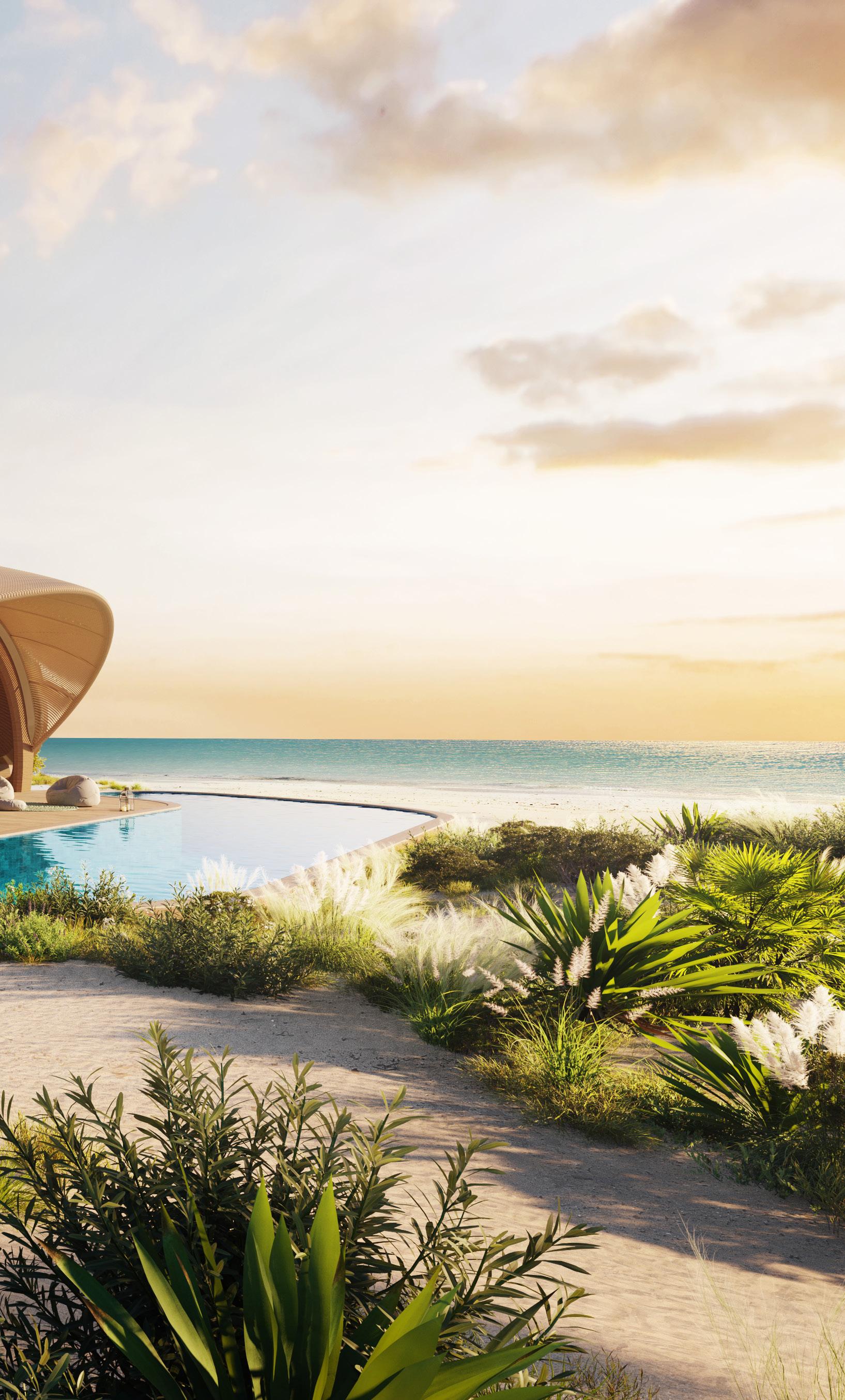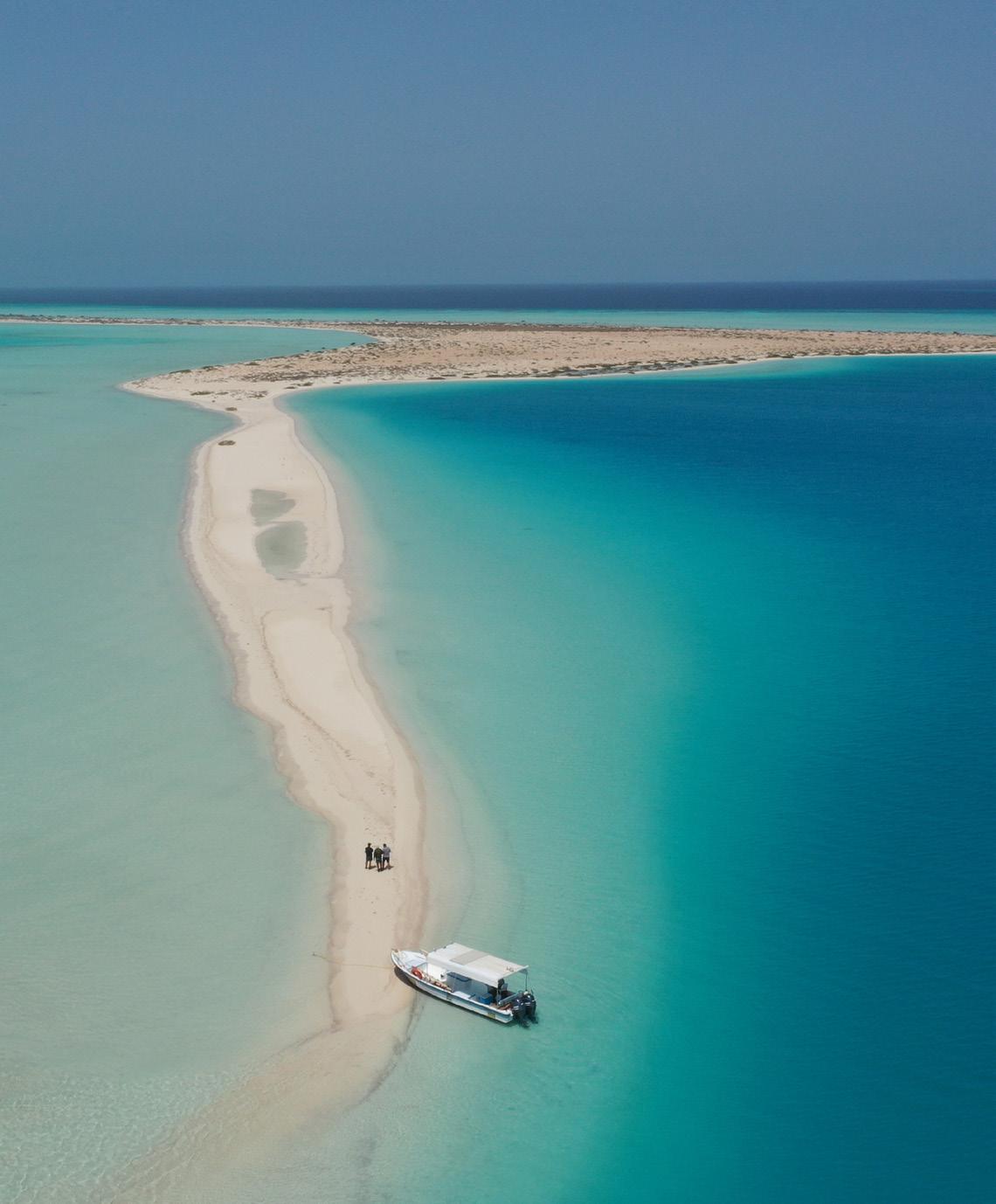
6 minute read
Building on nature and sustainable tourism in Saudi Arabia
There is a new focal point for luxury tourism emerging in the Middle East. While the UAE’s glittering cities of Dubai and Abu Dhabi have been transformed beyond recognition in the past 25 years, Saudi Arabia is now tapping into this lucrative audience via property developer Red Sea Global.
As the name suggests, these developments hug the stunning Red Sea coast that the Kingdom is blessed with, while the recent rebrand from Red Sea Development Company to Red Sea Global is a sign of its long-term intentions.
Advertisement
For now, the focus is on two signature projects – projects that are already well on the way to completion, not just a fantasy sitting on some architect’s drawing board. No less than three hotels – including St Regis, Ritz-Carlton and Six Senses no less – will be welcoming their first guests this year, serviced by a new, dedicated airport. Another 13 hotels will be opening in 2024.
The terrain being developed by Red Sea Global – and indeed the other megaprojects backed by the Kingdom’s sovereign wealth fund Public Investment Fund (PIF) – is the ultimate blank canvas, which carries as many challenges as it does benefits. Not least, the need to not only preserve but actually enhance the natural habitat.
The CEO overseeing this once-in-alifetime opportunity is John Pagano, who will need to draw on every ounce of his near 40-year international career to make this dream a realty reality. He shares his vision, and that of Red Sea Global, exclusively with Business Chief.
Q | In your own words, how would you describe Red Sea Global?
A | Red Sea Global is a world leader in responsible property development and regenerative tourism. We are creating two of the most spectacular luxury tourism destinations on the planet, The Red Sea and Amaala, and we’re putting the natural world and our local communities at the core of everything we do. We’re setting new standards for sustainability, and we welcome others in our industry to join us in proving that tourism can be a force for global good.
Q | Can you explain the rationale for the rebrand from Red Sea Development Company to Red Sea Global?
A | We rebranded last year as Red Sea Global to reflect our transformation from a developer of a single destination to one with projects up and down Saudi Arabia’s Red Sea coast and the abilities and aspiration to one day expand abroad. Our brand expresses our confidence that we can draw on the lessons we’ve learned about regenerative tourism to contribute to our industry on a broader, global scale. For example, we recently formed a partnership with The Ocean Race, one of the biggest events in international sailing, to promote ocean health as well as a lasting sporting legacy in Saudi Arabia. We see ourselves as a company of visionaries and innovators that aims to do better for people and planet.
Q | Saudi Arabia aims to have a sustainable tourism industry, including your projects. Can you outline some of the key initiatives making the development sustainable?

A | From Day One, our objective has been to set new standards for the tourism industry by not just conserving the environment but enhancing it. At The Red Sea destination, we’re developing just 22 of more than 90 islands.
We’re preserving the remaining 75% of those islands, nine of which we’ve designated as special conservation zones. Overall, less than 1% of the area will be developed.
Our resorts will generate zero waste to landfill and ban all single-use plastics once operational. We’re also capping our annual number of visitors at both The Red Sea and Amaala to protect their precious ecosystems.
We’re led by science, and one of our first steps at The Red Sea destination was to thoroughly assess a pristine lagoon at the heart of the project site, using marine spatial planning. We drew up a list of actions to help ease pressure on the lagoon’s environment, from cleaning beaches to rebuilding fish stocks. A peer-reviewed scientific journal in Switzerland even published our study.
In a separate effort, we surveyed the wildlife and habitats of 200 kilometers of coastline; no property developer has done a bigger environment survey. This survey serves as a baseline for us to track progress toward our goal of achieving a 30% net conservation benefit by 2040.
We’re also farming corals and planting and restoring mangrove trees, one of nature’s best defenses against global warming. We use treated wastewater from our constructed wetlands sewage treatment plant – the biggest of its kind in the Middle East – to irrigate our landscape nursery, also the largest in the region.
To reduce our carbon footprint, we’re installing the world’s largest microgrid supplied exclusively by renewable energy. Our solar farms have surpassed 85% completion, and we’re building the world’s biggest battery storage facility. Our water desalination plants and our other utilities and infrastructure, as well as our land vehicles and boats, will be powered entirely by electricity generated from renewable energy.
Q | How are you protecting the environment?
A | To expand on the above, Red Sea Global will own and operate Saudi Arabia’s first-ever fleet of carbon-neutral electric buses, as part of our e-mobility and zero-carbon strategy. We’ve also partnered with a company called ZeroAvia to develop seaplanes powered by hydrogen fuel cells. And we’re investing in a battery storage facility that will, at 1,200MWh, be the largest of its kind, enabling The Red Sea destination to be powered by 100% renewable energy day and night. Both The Red Sea and Amaala are planned to run exclusively on renewables. Other initiatives include our installation of innovative floating nurseries for corals. These offshore nurseries have achieved a 90% success rate, and our findings may contribute to protecting coral reefs in other parts of the world. We’re also planting and restoring millions of mangroves. Independent research suggests that tree for tree, mangrove forests can sequester up to four times more carbon than other land-based forests. They’re also hotbeds of biodiversity. Our landscape nursery, the largest in the Middle East, is already home to more than two million plants and trees that will beautify our destinations while creating new terrestrial habitats.
Our decision to develop only 1% of the total area at The Red Sea destination speaks for itself. Once The Red Sea and Amaala become operational, we will limit the number of visitors at both destinations to help protect habitats and wildlife, including the critically endangered Hawksbill sea turtle and Halavi guitarfish and the regionally endangered sooty falcon. We will limit The Red Sea to one million visitors annually, and Amaala to 500,000.
Q | What makes the region you are developing unique and special – attractive to tourists?
A | We’re developing an incredibly diverse region. It ranges from an archipelago of idyllic islands fringed by the world’s most vibrant coral reefs to rugged mountains, dormant volcanoes and dramatic desert dunescapes. There’s no shortage of opportunities to explore both above and below the water and to learn first-hand about the unique local culture and traditions from the region’s gracious and welcoming residents. This corner of Saudi Arabia is a hidden gem for international tourism. And it’s all within eight hours of flying time for 85 percent of the world’s population.
Q | The Red Sea will be ready to welcome the first guests in 2023 – is that going to happen?

A | We are firmly on track to welcome guests this year to our first resorts at The Red Sea. They are our Six Senses Southern Dunes, and the St. Regis and Nujuma Ritz-Carlton Reserve resorts, located on a collection of islands known as Ummahat.

Thirteen more hotels will open in 2024 to complete our first phase at the destination. We plan to raise that number to 50 hotels once the project is completed. At Amaala, we are developing eight hotels in the first phase of the Triple Bay development and plan to welcome our first guests in 2024.
Q | Is the International Airport also due to open this year?
A | Yes, our Red Sea International Airport will open this summer, with capacity to handle domestic arrivals from both Riyadh and Jeddah. By 2024, it will be able to accommodate international flights. It will be powered solely by renewable energy, like the rest of The Red Sea destination, and is on track to become the first carbon-neutral airport in the Middle East.
Q | What other milestones will be hit in 2023?
A | This will be a pivotal year for our company. We’ll be opening our first three hotels and our dedicated airport, transforming The Red Sea from a project to a destination. We’re also pushing
Our landscape nursery is the largest in the region and will provide more than 25 million plants for landscaping our destinations by 2030 ahead with the remaining 13 hotels in the destination’s first phase, as well as eight resorts at Amaala. That’s enough to keep us busy for now, though we hope to make some exciting announcements throughout the year regarding our growing portfolio of projects and subsidiaries!
Q | You have just taken delivery of the villas for the Sheybarah Island resort. Is that a significant milestone?
A | The first of our orb-shaped over-water villas arrived at Sheybarah Island in early January. They were manufactured by Grankraft in the United Arab Emirates and shipped to us by sea. We’ll take delivery of the remaining villas throughout this year.
These amazing villas are clad in stainless steel and will perch above the crystal waters off Sheybarah Island, about 30 minutes by boat from the mainland. They’re a great example of the efforts we make to minimise our impact on the environment at The Red Sea. By having the villas manufactured off-site and shipped to us ready-made, we need only to install them, thus avoiding any potential disturbance to delicate wildlife habitats by having to construct them on-site.





